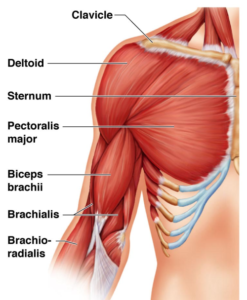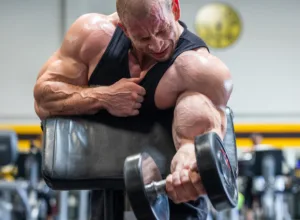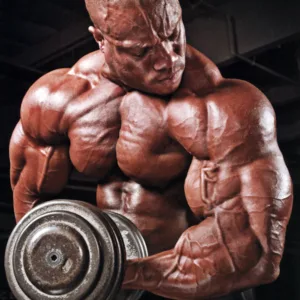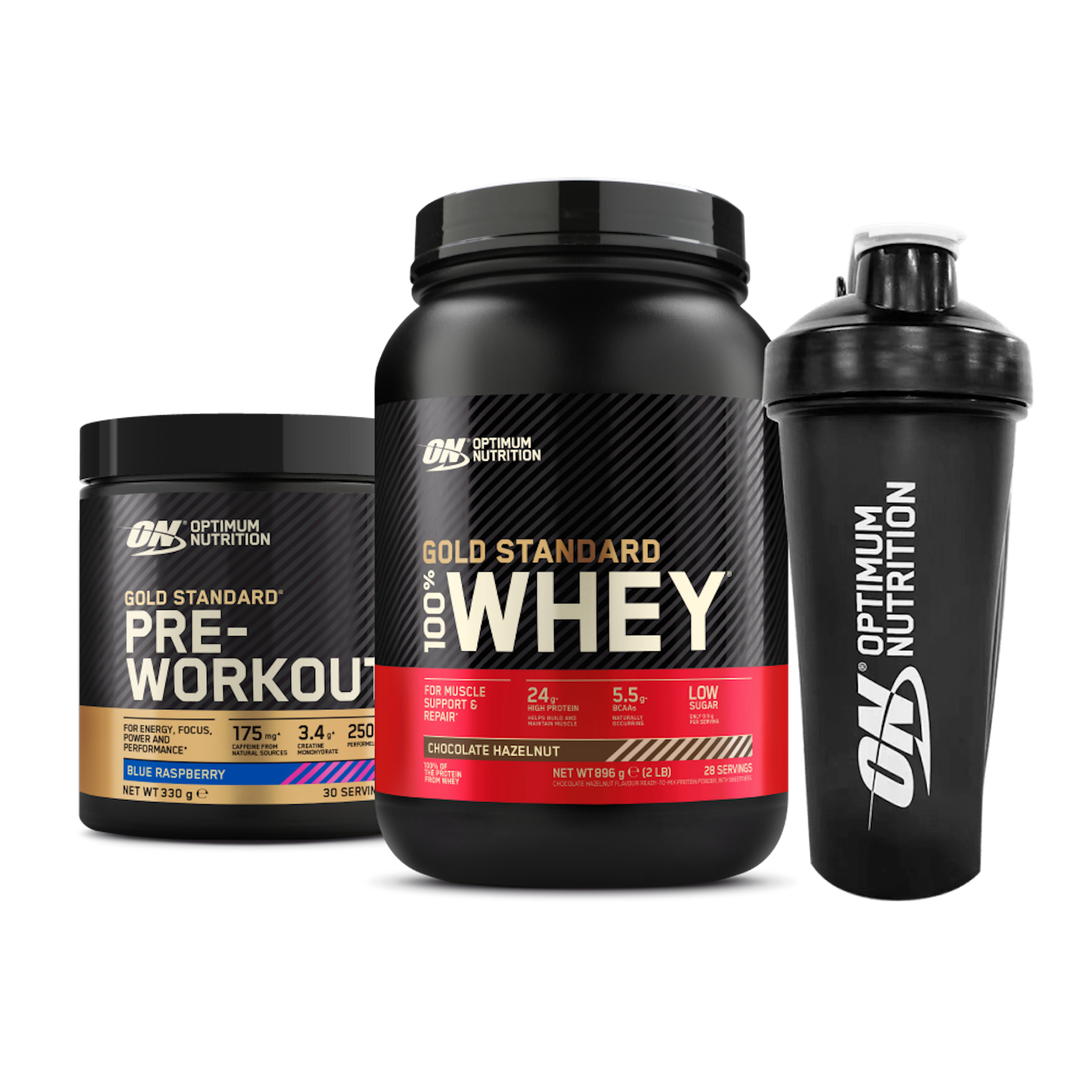Strong, defined biceps are a coveted goal for many gym-goers. They contribute to a sculpted upper arm and a more muscular physique. But simply curling dumbbells endlessly won’t necessarily get you there.
The biceps are one of the most important muscles in bodybuilding. Almost everyone who lifts weights wants bigger, shapelier biceps. Learn how to target the short head of biceps to build your biggest, best arms ever!
The biceps brachii, or biceps for short, is the most famous muscle in the human body. Even non-exercisers can point to where their biceps are!
The biceps brachii has two distinct heads; the long head and the short head. Both originate on the scapulae or shoulder blade and come together and insert onto the radius bone of the forearm.
Here, we explore the best bicep exercises and training strategies to maximize bicep growth and achieve those enviable upper arms.
Understanding Bicep Anatomy
The biceps brachii, commonly called the biceps, is a two-headed muscle on the front of the upper arm. It’s responsible for elbow flexion (bending your arm) and supination (rotating your forearm). The two heads of the biceps are:
- Long head: Originates at the shoulder joint and crosses the elbow joint. Flexes the elbow and helps with supination.
- Short head: Located entirely within the upper arm. Flexes the elbow.

 However, the short head is attached to the front part of the scapula, while the long head attaches more toward the rear. The short head is located on the inner arm and gives your biceps their width. In contrast, the long head is responsible for your biceps peak.
However, the short head is attached to the front part of the scapula, while the long head attaches more toward the rear. The short head is located on the inner arm and gives your biceps their width. In contrast, the long head is responsible for your biceps peak.
Both biceps heads flex your elbow and are involved in the supination of your forearm as well as flexion of your shoulder. While it’s impossible to isolate one head from the other, there are several biceps exercises you can do that emphasize the short head.
Use these exercises to build biceps thickness.
1. Preacher Curls
Golden-era bodybuilder Larry Scott was famous for his massive biceps. Scott’s unique arms helped him win two Mr. Universe titles and two Mr. Olympias. Larry Scott’s biceps were remarkably thick, something that he attributed to preacher curls. Scott was such a fan of preacher curls that this exercise became known as Scott curls.
There are several preacher curl variations you can use to target your inner biceps:
- Dumbbell preacher curls
- Barbell preacher curls
- EZ bar preacher curls
- Cable preacher curls
- Reverse dumbbell preacher curls
- Dumbbell hammer preacher curls
With all preacher curl exercises, your upper arms should stay pressed into the angled pad; keep them stationary to ensure your biceps do all of the work. Start each rep with your arms straight but not locked. Overextending your elbow could cause joint pain or biceps injury.
Curl the weight up slowly until your forearms are vertical. Don’t bend your arm too far, or you’ll take tension off your biceps. Lower the weight under control and, without bouncing, transition smoothly into another rep.
2. Supine Cable Curls
Supine cable curls are a very strict biceps exercise. Lying on the floor means you cannot use your back or legs to help you lift the weight; it’s biceps power all the way!
This exercise is best done for medium to high reps using light to moderate weights. It’s not really suitable for heavy weights or low reps. Use a straight or EZ bar as preferred.
How to do it:
- Attach your handle to a low pulley machine. Grab the handle with an underhand, shoulder-width, or wider grip.
- Lie down on the floor with the pulley between your feet. Tuck your upper arms into your sides.
- With your shoulders pulled down and back, abs braced, and head resting on the floor, bend your arms and curl the handle up to your shoulders.
- Extend your arms and repeat.
3. Cable Rope Hammer Curls
Cable rope hammer curls are mostly thought of as a biceps brachialis exercise. While the neutral hand position DOES increase brachialis activation, it’s also an excellent way to hit the short head of your biceps.
Subsequently, this move will add thickness to your biceps AND bulk up your forearms, making it a useful twofer.
4. Wide Grip Barbell Curls
Barbell curls are a classic mass exercise. Using a barbell, you can go heavy and really overload your biceps, making them great for building size and strength. They’re typically done using a hip to shoulder-width grip, which maximizes biomechanical efficiency so you can lift the heaviest possible weights.
However, if you move your hands out beyond shoulder-width, you can use this exercise to emphasize your inner biceps. How wide? That’s up for debate, but your hands should definitely be wider than shoulder-width apart.
Move them out an inch or two to see how you respond to this exercise. Experiment with your grip width to find your short head sweet spot. You can also do wide grip barbell curls using an EZ bar, which may be easier on your wrists.
How to do it:
- Grip your barbell with an underhand, wider than shoulder-width grip. Stand up straight, brace your abs, and bend your knees slightly for balance. Pull your shoulders down and back.
- Without using your legs or back, bend your arms and curl the weight up to your shoulders. Keep your wrists straight.
- Lower the bar back down and repeat.
Check Out Our List Of The Best Supplements For Building Muscle, Shredding Muscle, Recovery, And Great Health, and Wellness Products! Purchase ifbnewsfeed.org‘s apparels Here: ifbnewsfeed.org

 5. Reverse Curls
5. Reverse Curls
This is another exercise usually associated with the biceps brachialis that is also a useful short head exercise. Reverse curls are done with a pronated (palms down) grip instead of the more usual supinated or palms up grip. This is not a very biomechanically efficient position, so you won’t be able to lift as much weight as usual. However, this is still an effective inner biceps and forearm exercise.
You can do reverse curls several ways:
6. Zottman Curls
This exercise is named after George Zottman, who was an American strongman famed for his massive arms. Zottman was born in 1867 and died in 1942, and was from Philadelphia, PA.
Zottman curls are an old-school biceps exercise. They work both the biceps brachii and the brachialis, with a useful emphasis on the short head of the biceps. This means they’re a very time-efficient exercise and ideal for when you want a complete biceps workout but only have time for one exercise.
Zottman curls can be done standing, but for more isolation and less potential for cheating, you can also do them seated.
7. Dumbbell Concentration Curls
Dumbbell concentration curls are so-called because they allow you to really concentrate on the muscle you are training. They all-but eliminate upper back and leg involvement, making them a very strict exercise. Concentration curls also increase muscle activation toward the top of each rep, which is what makes them such an effective short head exercise.
This exercise works best when done with light to moderate weights and medium to high reps. This is not a heavyweight strength training exercise. Instead, keep your rests short and chase the pump!
8. Spider Curls
While this exercise won’t turn you into a superhero like the Amazing Spider-Man, it is a useful exercise for targeting your inner biceps. Spider curls, also known as prone incline curls, are also a cheat-free exercise as your body is supported by a bench, and it’s very hard to use momentum to help you lift the weight.
To do spider curls, set an adjustable bench to about 45-degrees and then lie face down, with your arms hanging down toward the floor. Use dumbbells, a barbell, or an EZ bar as preferred. Curl the weight up to your shoulders and then lower it again. Go light; this is a very strict arm exercise. Use a wide grip to really hammer those inner biceps.
9. Seated Barbell Curls
This unusual way of doing curls increases short head biceps activation by preventing you from extending your arms. It can be done using dumbbells or an EZ bar but works best with a straight barbell.
How to do it:
- Adjust your bench so that the backrest is close to vertical. Hold a barbell with a shoulder-width, underhand grip. Sit on the bench and rest the barbell on your thighs.
- Keeping your back against the backrest, bend your arms and curl the bar up to your shoulders.
- Lower the bar back to your legs and repeat.
- You can also do this exercise with a wider than shoulder-width grip to increase inner biceps activation even more.
10. Chin-ups
Don’t worry; you haven’t accidentally started reading an article on back training! While chin-ups are an excellent lat exercise, they’re also a useful arm movement that emphasizes the inner biceps.
The main advantage of this exercise is that you can go really heavy without resorting to cheating. After all, can you curl your bodyweight?
The key to making chin-ups a good short head exercise is to make sure you pull your chin all the way up and over the bar; no half-repping! It’s the top of each rep that really hammers your inner biceps.

 Short head Biceps Workout
Short head Biceps Workout
You can beef up your inner biceps by adding any of these exercises to your current arm workouts. But, if you are serious about increasing the size of your short head, give this workout a try.
Do it once a week, a few days after your usual arm workout. Yes, that’s right, we want you to train your biceps twice a week to shock them into new levels of strength and size!
| Exercise | Sets | Reps | Recovery | |
| 1 | Chin-ups | 4 | 6 | 120 seconds |
| 2 | Preacher curls | 3 | 8 | 90 seconds |
| 3 | Zottman curls | 2 | 10 | 60 seconds |
| 4 | Concentration curls | 2 | 12 | 45 seconds |
Short Head Bicep Exercises – Wrapping Up
All biceps exercises involve the short head, so it may not be necessary to spend extra time working on this muscle. That’s especially true if you are a recreational (non-competitive) bodybuilder or are more interested in strength and performance than muscle size.
However, if your goal is to sculpt the most aesthetically pleasing physique possible, you can’t afford to have any weak links. Doing more inner biceps work could be the difference between building good arms and GREAT arms.
Use these exercises to bulk up your inner biceps and give your arms more thickness.
Training Tips for Bicep Growth
- Focus on form: Proper form is crucial for maximizing muscle activation and preventing injuries. Don’t sacrifice form for heavier weights.
- Mind-muscle connection: Focus on feeling the contraction in your biceps throughout the movement. This will help you engage the muscle fibers more effectively.
- Progressive overload: Gradually increase the weight, sets, reps, or difficulty over time to keep challenging your muscles and stimulate growth.
- Train biceps twice a week: Allow enough recovery time between bicep workouts, ideally 2-3 days.
- Don’t neglect other muscle groups: Building a balanced physique is essential. Include exercises for your triceps, chest, shoulders, and core for overall upper body development.
- Proper diet and sleep: Muscle growth requires proper nutrition and adequate sleep. Eat a healthy diet with enough protein and get 7-8 hours of sleep per night.
Additional Considerations
- Genetics: Genetic factors play a role in muscle growth potential. Some individuals may see faster bicep development than others.
- Rest and recovery: Allow your muscles sufficient rest between workouts for optimal recovery and growth.
- Stretching: Don’t forget to stretch your biceps after workouts to improve flexibility and prevent tightness.
Sample Bicep Workout Routine
Here’s a sample bicep workout routine you can incorporate into your training program:
Day 1:
- Pull-ups (3 sets of as many reps as possible)
- Barbell rows (3 sets of 8-12 reps)
- Barbell curls (3 sets of 10-15 reps)
- Hammer curls (3 sets of 12-15 reps)
Day 2:
- Chin-ups (3 sets of as many reps as possible)
- Preacher curls (3 sets of 10-12 reps)
- Concentration curls (3 sets of 12-15 reps)
- EZ-bar curls (3 sets of 8-12 reps)
Wrapping Up
Sticking to your bicep training routine, focusing on proper form, and gradually increasing intensity will help you develop those sought-after bigger and stronger biceps.
More About Increased Bicep Size and Massive Biceps Contents
- Here Are “The 7 Bicep Exercises” You’re Not Performing To Add Size To Your Arms
- Biceps Development: 10 Commandments Of “How to Build A Massive Biceps”
- The “3 Under-Utilized Bicep Exercises”. Utilize Them In Your Arms Day To Build Up Peak Biceps

- Hormone Replacement Therapy regimen For Men and women
- Hormone Blood Testing for Men (Bodybuilder Blood Testing)
- Shop Optimum Nutrition Energy: Anytime & Pre-Workout
For More News And Daily Updates, Follow IFBNewsfeed.Org™🇺🇸 on Facebook, Twitter, and Instagram. Comment, Like, And Share With Everyone Who May Need To Be Updated With The Most Recent Fitness/Bodybuilding/Powerlifting And CrossFit News.







